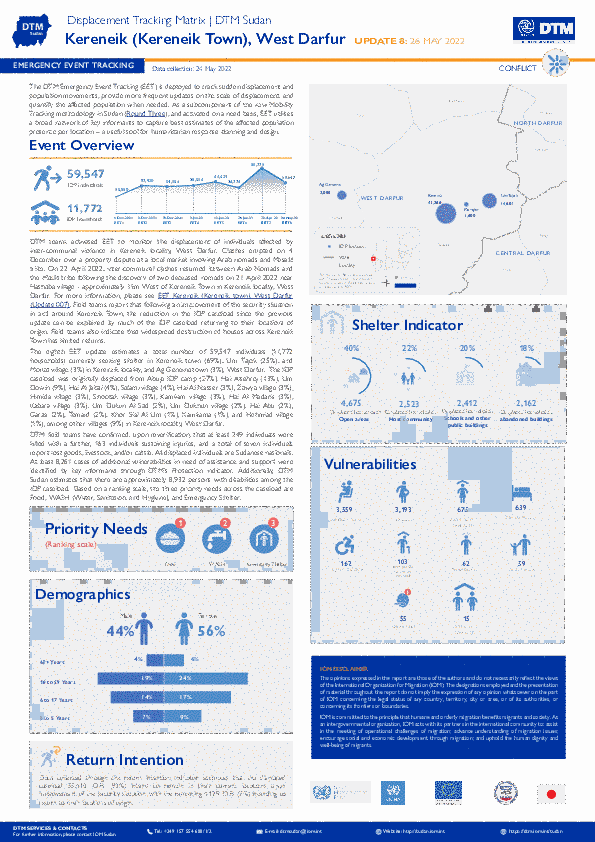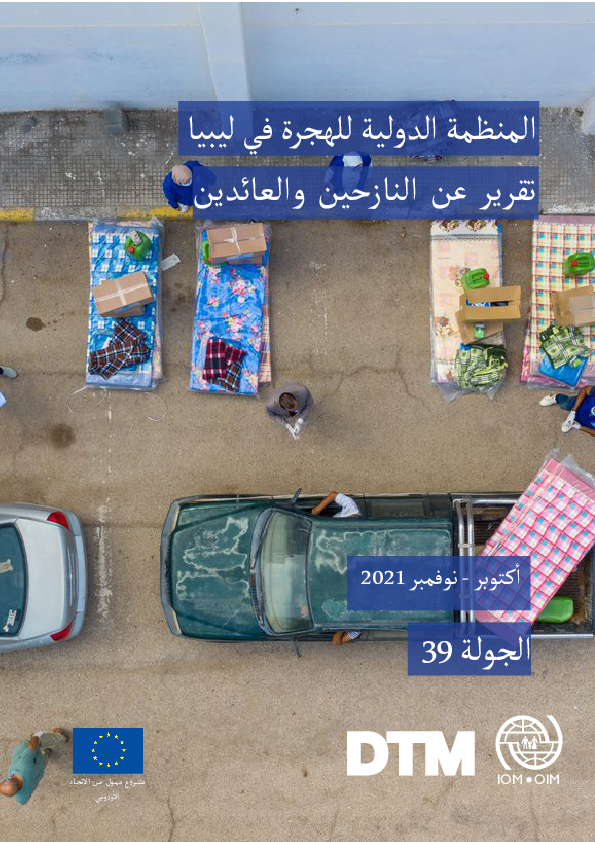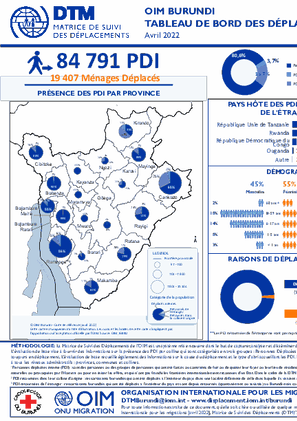-
Countries
-
Data and Analysis
-
Special Focus
-
Crisis Responses
Contact
DTM Burundi, DTMBurundi@iom.int
Location
Burundi
Activity
- Mobility Tracking
- Baseline Assessment
Period Covered
Apr 04 2022 -Apr 20 2022
A baseline assessment is a sub-component of mobility tracking. It aims to collect data on IDP, migrant or returnee population presence in a defined administrative area of the country.
Population Groups
Survey Methodology
Unit of Analysis Or Observation
Type of Survey or Assessment
Keywords
Geographical Scope
Administrative boundaries with available data
The current dataset covers the following administrative boundaries

Contact
DTM Mauritania, DTMMauritania@iom.int
Language
French
Location
Mauritania
Period Covered
Nov 01 2021
Jan 31 2022
Activity
- Survey
- Flow Monitoring Survey
- Flow Monitoring
- Mobility Tracking
Ce rapport présente les principaux résultats obtenus de novembre 2021 à janvier 2022, à travers les trois outils de suivi des mouvements de transhumance de l’OIM : le comptage, l’alerte et l’enquête détaillée. L’OIM, en partenariat avec les groupements pastoraux (GNAP et TASSAGHT) en Mauritanie et au Mali, a mis en œuvre ces outils au niveau de 12 localités de forte mobilité et de concentration de transhumants transfrontaliers, situées entre le Mali et la Mauritanie.
Durant la période de collecte de données, les transhumants observés au niveau de la frontière Mali, Mauritanie se déplaçaient de la Mauritanie vers le Mali. Cette tendance s’explique par le fait que cette période coïncidait avec la fin des récoltes au niveau du Mali. De ce fait, les transhumants qui étaient en Mauritanie se rendent au Mali à la recherche de pâturage à cause du déficit de pâturage noté en Mauritanie.
La grande majorité des transhumants interviewés dans les points de collecte de données, était de nationalité malienne (61%) et mauritanienne (36%). Les principales zones de départs sont entre autres les régions de Hodh El Gharbi (50%), Assaba (20%), Hodh Ech Chargi (12%) et autres (18%). Ils se dirigeaient essentiellement vers les régions de Kayes (63%) et Koulikoro (37%).
Les conditions et l’environnement de voyage font que la transhumance est réservée aux plus jeunes. L’âge moyen de la population transhumante enquêtée sur l’axe transfrontalier mauritano-malienne était de 36 ans. En effet, 84 pour cent des transhumants sont dans la classe d’âge 18-45 ans. L’évaluation du niveau d’éducation montre que la majorité des transhumants enquêtés (45%) ont fait l’école religieuse (école coranique), 36 pour cent ont affirmé ne pas fréquenter une école. La grande majorité des transhumants enquêtés (75%) est propriétaire des troupeaux qu’ils accompagnent dans leur mouvement de transhumance.
Durant la période de collecte, dans la zone frontalière du Mali et de la Mauritanie, au total 144 alertes ont été remontées par les sentinelles, dont 94 évènements et 50 mouvements. Dans le cadre du projet, un ensemble d’actions a été mis en place pour atténuer les conséquences des alertes, notamment par les comités villageois pour des besoins de médiation, de sensibilisation par information des relais de veille et d’alerte. Ces comités et relais, grâce aux informations collectées par le mécanisme d’alerte, ont pris part à la résolution de plusieurs conflits liés à occupation des champs de culture par les transhumants, des blessures d’animaux par des coups volontaires sur les animaux des éleveurs transhumants. Le rôle joué par les relais et comités villageois est important dans la mesure où les comités villageois dans leur mission de médiation ont pu circonscrire et éviter des conflits. Certains comités villageois ont contribué à la recherche et récupération de troupeaux par le biais des informations issues des relais de veille et d’alerte.

Contact
DTM Libya, DTMLibya@iom.int
Language
English
Location
Libya
Period Covered
May 18 2022
May 28 2022
Activity
- Other
As part of the third phase of the Libyan national COVID-19 vaccination campaign led by the Libyan National Centre for Disease Control (NCDC), IOM conducted awareness raising sessions on COVID-19 vaccines with a total of 1150 adult migrants in six locations, Triq al Sika, Triq al Matar, and Ain Zara detention centres and community settings in three municipalities, Hai Alandalus, Suq Aljumaa and Tajoura. Additionally, 694 (684 migrants and 10 Libyans) have received COVID-19 vaccination in seven locations during the reporting period (18 - 28 May 2022).

Contact
DTM Sudan; dtmsudan@iom.int
Language
English
Location
Sudan
Snapshot Date
May 24 2022
Activity
- Mobility Tracking
- Event Tracking
The DTM Emergency Event Tracking (EET) is deployed to track sudden displacement and population movements, provide more frequent updates on the scale of displacement, and quantify the affected population when needed. As a subcomponent of the new Mobility Tracking methodology in Sudan (Round Three), and activated on a need basis, EET utilises a broad network of key informants to capture best estimates of the affected population presence per location – a useful tool for humanitarian response planning and design.

Contact
DTM Libya, DTMLibya@iom.int
Language
Arabic
Location
Libya
Period Covered
Oct 01 2021
Nov 30 2021
Activity
- Mobility Tracking
- Baseline Assessment
يعرض هذا التقرير البيانات المجمّعة فيما بين شهري أكتوبر ونوفمبر من سنة 2021 حول النازحين داخليا والعائدين. وتمثّل هذه البيانات والمستخلصات الجولة 39 من تتبع التنقل في ليبيا التي أجرتها مصفوفة تتبع النزوح. ولم يتم الإبلاغ عن أيّة حركات نزوح كبرى منذ شهر يونيو من سنة 2020 وطوال السنة الجارية، فيما تواصل نسق عودة الأسر النازحة مسبقا إلى مناطقها الأصلية. وتماشيا مع التوجه الذي امتد على مدار السنة، استمرّ انخفاض عدد النازحين في ليبيا في هذه الجولة، ورافق ذلك ارتفاع في عدد العائدين. وقد ارتفع عدد العائدين في الجولة 39 ليبلغ 661.892 عائداً في مقارنة بالجولة 38 التي تم فيها تسجيل 648.317 فرداً. ويشير ذلك إلى زيادة طفيفة في نسبة العائدين (بنسبة 2 في المائة) بعد فترة من الاستقرار دامت على مدار الأشهر الستة الأخيرة. وفي أعقاب موجة العودة، تواصل عدد النازحين في الانخفاض في هذه الجولة، ممّا يقدّر بـ 199.949 نازحاً في شهر سبتمبر من سنة 2021 إلى 179.046 نازحاً بنهاية شهر نوفمبر. ويمثّل ذلك انخفاض بما يقارب 21.000 فرداً (بنسبة 10 في المائة) على مدار فترة الدراسة وبالتزامن مع استمرار موجة عودة الأسر النازحة إلى مناطق أصلها.

Contact
DTM Burundi, DTMBurundi@iom.int
Language
French
Location
Burundi
Period Covered
Jan 01 2022
Mar 31 2022
Activity
- Flow Monitoring Survey
- Flow Monitoring
Ce rapport présente une analyse des enquêtes de suivi des flux (Flow Monitoring Survey, FMS) réalisées entre janvier 2022 et mars 2022. Au cours de cette période, 3 115 entretiens ont été menés auprès des voyageurs ayant traversé huit (8) points de suivi des flux (Flow Monitoring Points, FMPs): Gasenyi-Nemba frontalier avec le Rwanda au Nord du Burundi, Gatumba situé à la frontière avec la République Démocratique du Congo à l’Ouest du Burundi et six points de suivi de flux dont Kabogo, Mbundi, Kwa Rutuku, Mukambati, Kabuyenge et Kwa Buhinja installés à l’est du Burundi à la frontière avec la République Unie de Tanzanie. Ces enquêtes font partie des activités de suivi des flux mises en oeuvre par l‘OIM par le biais de la Matrice de Suivi des Déplacements (Displacement Tracking Matrix, DTM).

Contact
iomisbdtmremapteam@iom.int
Language
English
Location
Pakistan
Period Covered
May 07 2022
May 20 2022
Activity
- Flow Monitoring
IOM Pakistan collects data on the outflows of undocumented Afghan migrants at the Torkham and Chaman border crossing points in an effort to better understand the migration movements of undocumented Afghan migrants returning to Afghanistan from Pakistan. This exercise is part of the European Union funded project “Displacement Tracking Matrix Regional Evidence for Migration Analysis and Policy (DTM REMAP)”. From 07 to 20 May 2022, 5,147 undocumented Afghan migrants returned to Afghanistan, including 336 through the Torkham border point and 4,811 through the Chaman border point. During the reporting period, border authorities facilitated the return of 93 individuals due to the lack of legal documentation to remain in Pakistan. Therefore, information concerning these 93 individuals is not included in the report analysis.

Contact
DTM Burundi, DTMBurundi@iom.int
Language
English
Location
Burundi
Period Covered
Apr 01 2022
Apr 30 2022
Activity
- Mobility Tracking
- Baseline Assessment
DTM has identified 84,791 internally displaced persons (IDPs) in 19,407 households, 91% of the displacement were due to natural disasters and 9% other reasons in the month of April 2022 covering all 18 provinces of Burundi.

Contact
DTM Burundi, DTMBurundi@iom.int
Language
French
Location
Burundi
Period Covered
Apr 01 2022
Apr 30 2022
Activity
- Mobility Tracking
- Baseline Assessment
La DTM a identifié 84 791 personnes déplacées internes (PDI) réparties dans 19 407 ménages déplacés, 91% des déplacements étaient dus à des désastres naturels et 9% à d'autres raisons.

Contact
DTMUkraine@iom.int
Language
English
Location
Ukraine
Period Covered
May 17 2022
May 23 2022
Activity
- Survey
Between 17 and 23 May the International Organization for Migration (IOM) conducted the fifth round of a rapid representative assessment of the general population in Ukraine to gather insights into internal displacement and mobility flows, and to assess local needs. This general population survey serves to identify areas with high humanitarian needs and to inform the targeting of response aiming to assist the war affected population The geographical scope of the assessment covers the entire territory of Ukraine, all five macro regions (East, North, Centre, South, and the city of Kyiv), with the exception of the Crimean peninsula. The general population survey was constructed through a random digit dial (RDD) approach, and 2,001 unique and anonymous respondents aged 18 and over were interviewed using the computer assisted telephone interview (CATI) method. The estimates rely on the UNFPA population data for Ukraine, agreed upon as the common population baseline by the humanitarian community. Those currently outside Ukraine were not interviewed. For further notes on method and limitations, including IOM’s definition of internally displaced persons used for the purpose of this assessment, see page 11. In addition to this General Population Survey, data on recorded IDP presence at hromada level in Ukraine are available from IOM’s Displacement Tracking Matrix Baseline Assessment (Round 3 May 15 2022, HDX, registration required).